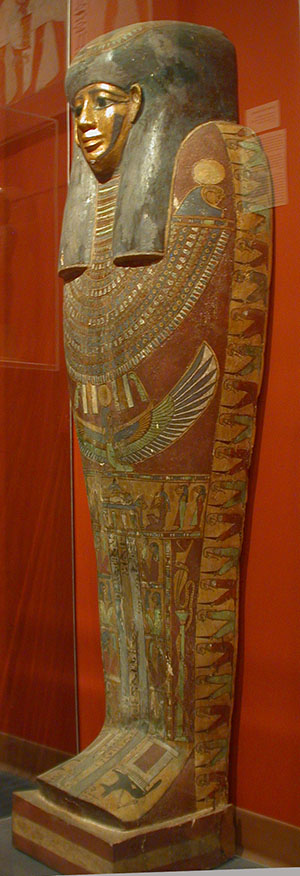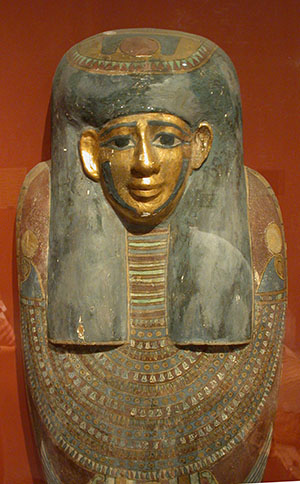Institute of Egyptian Art & Archaeology
Selection of Ancient Egyptian Artifacts
Irtw-irw: Mummy, Coffin and Cartonnage Set
Mask, Chest and Plates: cartonnage, painted and gilded (mask and coffin face only)
Coffin: wood, painted and gilded
Date: Probably Early Ptolemaic Period (305-150 B.C.E.)
Provenance: Attributed to Akhmim
Irtw-irw's name (pronounced "ear-too ear-oo") means "may the eye (of the god) be against them." In other words, may the eye of the god protect Irtw-irw from his enemies. His mummified body reminds us of the importance of mummification in ancient Egyptian funerary belief.
Irtw-irw's funerary mask would have been positioned directly over the face and upper chest of his mummy on top of the mummy wrappings (the latter were removed prior to his arrival in Memphis). The mask depicts the facial features in a traditional manner. The features are not individualized to look like Irtw-irw, but picture him as if in the prime of life. Note that the mask is similar to the carved and painted face on the coffin lid.
Irtw-irw's coffin lid is decorated with many images derived from ancient Egyptian mortuary religion. The outstanding feature of the coffin lid (IEAA 1985.3.1a) is the gilded face of Irtw-irw framed by a huge, blue wig. The gilded face and dark blue wig suggest that at death Irtw-irw became like a god, with flesh of gold and hair of lapis lazuli. A brightly painted collar with floral/plant motifs covers Irtw-irw's chest. Note the falcon heads with solar disks at the right and left sides of the collar. Below this broad collar is an image of a winged goddess. She wears a sun disk on her head and her arms extend into wings which stretch protectively around the mummy. In her hands are ostrich feathers, symbolic of truth. The deceased had to have his heart weighed against the feather of truth in the afterlife. If his heart was "heavy" with misdeeds, then he was devoured by a monster named Ammit. If, however, his heart was "as light as a feather," the deceased was permitted to enter into the kingdom of Osiris, the ruler of the netherworld. Four blank white rectangles may have been intended to highlight brief inscriptions in this "off the shelf" coffin.
Below the image of the goddess is a lion bier (bed) on which the mummy is outstretched. The bier is flanked by images of Isis (right) and Nephthys (left). Isis, the wife of Osiris and goddess of magic wears on her head the hieroglyph for her name, the throne symbol. Nephthys, the sister of Isis and the protectress of coffins and canopic jars, is on the left and wears on her head the hieroglyphs for her name. The ba (one aspect of the soul) of the deceased, shown as a human-headed bird, hovers above the mummy. Below the bed are the four canopic jars which were used to hold and protect the internal organs of the mummy. The figures of Isis and Nephthys are each followed by two of the "Four Sons of Horus," minor divinities who protected the internal organs of the deceased.
Below this panel are three columns of a hieroglyphic text that is flanked by four anonymous figures of seated divinities, each with a feather of truth on their knees. These in turn are flanked by two cobras resting atop papyrus columns. The one on the right wears the crown of Lower Egypt and the one on the left the crown of Upper Egypt. The protective serpents also appear on the sides of the lower part of the coffin. On the feet of the coffin lid, placed upside-down to us, but so that Irtw-irw could see them, are two images of the jackal god Anubis (or possibly Wepwawet), a funerary god, reclining on a shrine representing the tomb. The name of Irtw-irw is written above the head of each figure.
Knife-holding guardian figures form a band around the edge of the coffin's lid.
The text on the lid of Itrw-irw's coffin is damaged, so only fragments can be read.
In 1987 Irtw-irw spent the day in the hospital while a medical team from the University of Tennessee Medical School examined him. He spent three hours going through a C.A.T. scan, and pathologists closely examined him. Later, an E.N.T. (ear, nose and throat) specialist looked inside Irtw-irw's head with sophisticated equipment. This exam, along with the C.A.T. scan, confirmed that Irtw-irw suffered from an ear infection. His cause of death is unknown. Although we do not know exactly when the hole on the side of his head and other damaged to his face and feet were made, they probably happened in relatively recent times - after the mummy was unwrapped - probably some time after he arrived in the United States. The examination also revealed that he may be younger than expected. Irtw-irw may have died at about 30 years of age.
Bibliography
Inv. no.: 1985.3.1
Statue of Nedjemu
Date: Old Kingdom, Dynasty V (c. 2500-2350 B.C.E.)
Material: Limestone
Provenance: Giza
Nedjemu ("sweet one") illustrates several aspects of Egyptian funerary sculpture which remained typical for almost 3000 years. His body indicates the use of the canon of proportion within an eighteen-square grid. His rigid posture and the quiet expression on his face reflect the Egyptian desire to represent the deceased in a manner appropriate for eternity.
Nedjemu wears a wrap-around kilt which would have been made of unbleached linen, a product of flax. (Cotton textiles in Egypt date no earlier than the third century B.C.E.) He holds two small pegs in his hands, probably abbreviated scepters as symbols of public office. His wig would have been made of human hair if he could afford it. However, cheaper wigs of sheep or goat hair were also available. Traces of reddish-brown paint on his legs illustrate the skin color associated most frequently with men. The left foot strides forward, the traditional pose for male statues. This stance suggests movement and strength.
This little statuette may have been an "off-the-shelf" purchase after Nedjemu's death. The inscribed hieroglyphs on the base tell us that it was acquired for Nedjemu's tomb by his son.
Check out Dr. Joshua Roberson's 3D images of Nedjemu on Sketchfab!
Inv. no.: 1987.2.1

Model Granary
Date: Middle Kingdom, Dynasty XII (c. 1938-1759 B.C.E.)
Material: Painted wood
Provenance: El Bersheh
Model scenes of daily life activities were popular for use in tombs during the Old and Middle Kingdoms. They complemented the paintings of similar scenes on the walls of the tombs. It is interesting to note, however, that the New Kingdom pursued an interest in wall paintings and statuary with a religious, not an everyday, emphasis.
The men in the granary perform various functions. In the larger room, a man delivers threshed grain to a kneeling man who grinds it. Another man standing in this room packs flour in a storage container. In the smaller room, a seated supervisor watches as a worker places flour in large storage jars. The figures are painted reddish-brown, the traditional skin color for men in Egyptian art. Also, they wear long linen kilts. The carving is rather crudely executed, and the long arms are out of proportion with the rest of the body; nevertheless, the sense of action generated by the figures creates a lively scene.
Inv. no.: 1981.1.11
Triangular Loaf of Bread
Date: First Intermediate Period, Dynasty XI, reign of Mentuhotep II (c. 2008-1957 B.C.E.)
Material: Bread
Provenance: Deir el Bahri, Mentuhotep II's mortuary temple
This loaf of bread is approximately 4000 years old. It was placed with other objects under the foundation of Mentuhotep II's mortuary temple at Deir el Bahri in Western Thebes. The objects placed in foundation deposits for ancient Egyptian temples were intended to symbolically stabilize and protect the four corners and the boundary walls of the temple, because the temple itself was believed to be a microcosm of the universe. One reward gained from a stable universe was food in abundance. This loaf of bread symbolizes that value.
During the bread-making process, the grinding of flour and the mixing of dough, small stones and the ever-present sand became part of any bread which was made, whether for offerings or for domestic use. These gritty elements wore down the enamel of the teeth which led to abscesses. Cavities, caused today by refined sugar, were not the culprits in tooth loss in ancient Egypt.
Inv. no.: 1981.1.14
Block Statue of Nedjem
Date: New Kingdom, Dynasty XIX, reign of Ramesses II (c. 1279-1213 B.C.E.)
Material: Quartzite
Provenance: Memphis, Egypt
Nedjem ("sweet one") sits on a cushion, his body covered with a robe, his knees bent so that they are almost level with his chin, his feet flat on the ground, and his arms crossed over his knees. The outline of his figure suggests a block, hence the term, "block statue." He has a small beard, full wig, and sandals. Between his legs is a smaller figure, which represents the god Ptah-Tatenen, a form of the Memphite god, Ptah, who was believed to be not only the creator god but also the land from which all was created. Ptah-Tatenen wears, on top of his wig, a crown composed of two feathers and a sun disk. He is wrapped as a mummy and holds a scepter. The hieroglyphic inscription in sunk relief on Nedjem's back pillar tells us that he was the "King's Scribe, Great Steward, King's Messenger to every foreign land, and Overseer of the Granaries of the Western Border."
The statue was placed in the Temple of Ptah in ancient Memphis to represent Nedjem for eternity. There is much evidence that lets us know that Nedjem is from Memphis. First, and most important, an Egyptologist found records of an excavation in ancient Memphis which took place about 1840. The discovery of this statue of Nedjem is recorded in this report. Also, the quartzite of Nedjem's statue is a stone found particularly in the Memphis area.
During the American Civil War, a Yankee sea captain trading in the Mediterranean docked at Alexandria, Egypt, with a half-empty ship. He bought the statue of Nedjem, along with some others, to serve as ballast. As the ship neared the American coast, it was captured by Confederate forces and escorted to New Orleans, where its cargo, including Nedjem, was taken to the Customs House. After the war, the statue was taken to Boston, where it stayed in a garden for years. Eventually, it entered the collection of the Museum of Fine Arts, Boston. In 1975, it was sold to The University of Memphis, together with 43 other Egyptian antiquities. Today, these artifacts form the core of the permanent collection of the Institute of Egyptian Art and Archaeology.
Inv. no.: 1981.1.20









